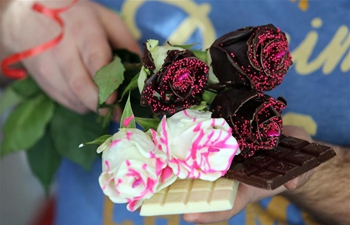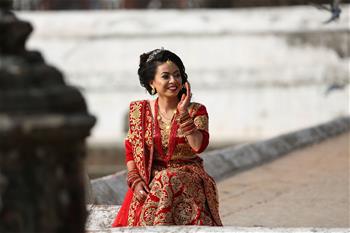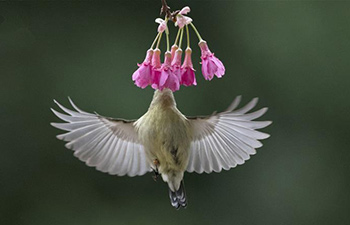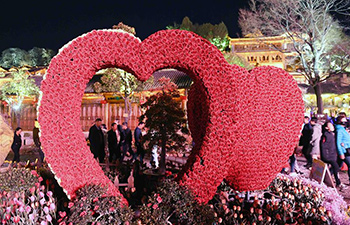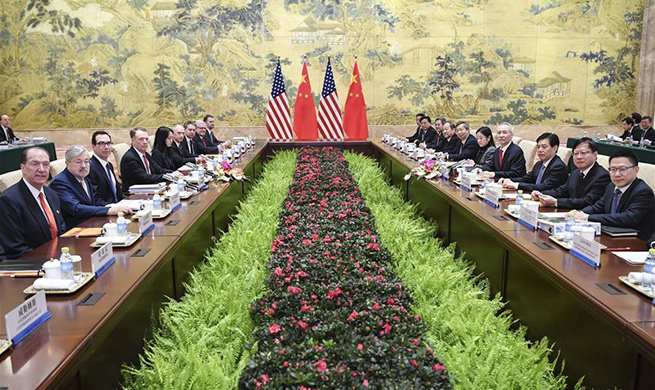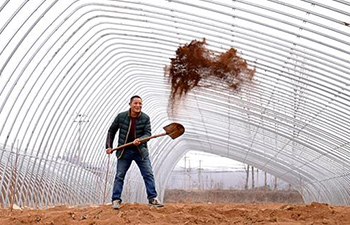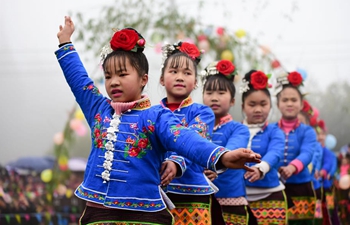HEFEI, Feb. 14 (Xinhua) -- Wearing a bright colored oil-cloth apron, 50-year-old Zheng Guoming is carefully brushing tung oil on an umbrella cover. Around him are orange oil-cloth umbrellas drying, filling the area with the scent of tung oil.
"Tung oil is the key to the durability of oil-cloth umbrellas," Zheng said, adding that it is necessary to brush carefully and evenly to assure the umbrellas' glossiness.
Zheng is the manager of Guoming Oil-Cloth Umbrella Factory in Gufeng Village, Jing County, eastern China's Anhui Province. He is a sixth generation inheritor of the ancient umbrella-making craftsmanship that boasts a history of around 1,000 years.
With the canopy being made from cotton fabric covered by tung oil, oil-cloth umbrellas are more solid and durable than the oil-paper umbrellas, another kind of Chinese ancient umbrella.
The history of the oil-cloth umbrella in Jing County can be traced back to the Song Dynasty (960-1276), and it flourished in Ming (1368-1644) and Qing (1644-1911) dynasties.
In the beginning, it was mainly used by the imperial family and was also used in rituals. For example, red oil-cloth umbrellas served as wedding items to ward off evil spirits. Later on, it gradually became popular among common people, according to Zheng.
"The umbrella has always been a part of my life," Zheng recalled. "It was so popular when I was a child that I needed to help my parents make the umbrella in my spare time." When Zheng was 19, he took over the umbrella factory.
The young factory manager was taken by surprise when people stopped using traditional umbrellas as modern and more portable foreign umbrellas swept over China in the 1980s.
"The oil-cloth umbrella was out of the market all of a sudden, and our annual demand slumped from 40,000 to just 10,000. Many umbrella factories went out of business rapidly," Zheng said. Until the early 1990s, Guoming Oil-Umbrella Factory was the only one in Jing County striving to survive.
Reform! With no other choice, Zheng did the only thing he could think of. He embarked on reforming the production management system to upgrade the quality of the products while lowering the price.
In order to improve durability, Zheng used bamboo that is 10 years old or older to make umbrella ribs and improved the tung oil recipe. "We have to lower the price to seize the market. The foreign umbrellas were sold at dozens of yuan each while our products were just five (74 U. S. cents) to six yuan then," Zheng said.
He also discovered a niche market brought by the emergence of self-employment after China's reform and opening up. The large oil-cloth umbrellas shielding pedlars from the sun or rain sold like hot cakes and were in short supply.
Thus, the oil-cloth umbrella earned back a spot in the market despite the prevailing modern umbrella. However, it's still far from its former glory. Accidentally, a discussion with a client led to a turnaround for Zheng's business. The client was willing to purchase oil-cloth umbrellas decorated with a traditional weaving technique called "chuan hua" (flower weaving) at a high price.
Chuan hua refers to crossing colorful cotton threads around the umbrella stretcher to weave exquisite flower patterns. This technique is so sophisticated and time-consuming that has been abandoned for a long time.
"It dawned on me that high-quality goods always have a market share," Zheng said. He began to restore the "chuan hua" technique and focus on making high-end oil-cloth umbrellas for interior decoration and as props in films and photo shoots.
Zheng made every effort to upgrade and innovate products, such as engraving patterns on umbrella handles and painting on the canopy.
He also customized oil-cloth umbrellas to meet individual requirements, making them popular not only in China but also overseas.
"Japanese and Korean clients prefer umbrellas with traditional Chinese cultural elements, such as Chinese ancient poetry, painting and calligraphy, while Dutch clients favor those made of eco-friendly fabric with bamboo handles. They just love it!" Zheng said.
Having finished an order of more than 2,000 environmentally-friendly oil-cloth umbrellas for a Dutch client, Zheng is now busy with another order from a Canadian who plans to pay a personal visit soon to learn more about the traditional Chinese oil-cloth umbrella culture.
Now, the annual export volume of his factory has reached 20,000, and the annual output has soared from 20,000 to 30,000 in the early 1990s to about 100,000 currently, among which high-end umbrellas account for 30 percent.
Photography has injected more vitality into this old craft. The wonderful combination of ancient factory buildings, professional craftsmen and ancient oil-cloth umbrellas makes the factory among the 100 "Best Photo Spots" in Xuancheng City, attracting more than 10,000 visitors every year.
Zheng plans to establish an umbrella photography base here.
Despite the promising situation, the passing years are constantly reminding Zheng of the inheritance dilemma. "It's difficult to attract young people into this career due to the long-term and high-intensity training. Apprentices need to learn for two to three years to master the whole processes," he said.
The production of tung oil can be another obstacle for them, in that it takes more than two hours to just make one bucket and it smells bad, he added.
Zheng hopes that he could open a study center for primary and middle school students in the future, so that children can have an access to this old craft and may have the interest to take it over.




